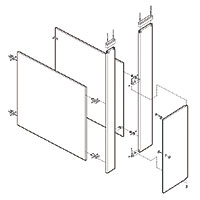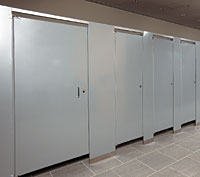Designing Public Rest Rooms: Privacy is in the Details
Design of High Traffic Areas
Toilet partitions must be strong and durable, to withstand daily abuse caused by normal traffic, including dents to scratches. When specifying toilet partitions, architects should consider materials that are compatible with peak demands of high traffic and frequency of use.
The huge volume of people using public bathroom facilities at a sports stadium can be as many as one quarter of the seating capacity during a timed break in the action. Building owners expect architects to consider these volumes, along with cost-effective facility maintenance. Public rest room facilities are subject to daily maintenance procedures to meet health department standards. Employees are required to wash their hands after using the facilities, and standards govern daily sanitization and bathroom cleaning. Toilet partitions, which are ceiling mounted or hung from the structure above, allow open floor space, better accessibility, and maintenance flexibility for mopping and cleaning each partitioned toilet area. Ideally, toilets are wall mounted for the same reasons, to save time and money, and to provide clean environments.
Hardware
During a concert performance intermission, especially at older theaters, it is not unusual to see lines of women waiting to use the rest rooms. Appropriate rest room design results in better fixtures, spatial relationships, and more individually partitioned toilet compartments. In older public rest rooms, the owner often must hire a monitor to expedite the flow of people. While not ideal, this step can ease the pressure of partition use and provide a measure of safety.
Some toilet partitions contain special color-coded indicator latches that signal if the stall is occupied, as used on commercial aircraft. These indicators consist of slide hardware in the latch mechanism exposing a red bar when the stall is occupied, and a green bar when unoccupied.
 Courtesy of Hadrian Manufacturing Exploded ceiling-hung partition. |
The simple style and lines of toilet partitions can be emphasized or streamlined through hardware details. Zinc, steel, and aluminum are materials used in hardware for toilet partitions. Heavy traffic can cause undue wear and tear on the toilet partition anchors. Panels should be durable enough to function well and withstand daily use in all public facilities, such as airports, which have high traffic volumes, and require frequent hardware checks and adjustments. Even though these areas must accommodate space for packages, luggage, and carry-on baggage, rest rooms are often designed with limited space to access these items.
Higher panels and appropriate hardware details contribute to safe toilet compartments, thereby preventing theft or the ability of an individual to reach underneath or overhead. This type of protection is often used within public rest rooms at train stations, airports, and bus terminals, where passengers are laden with packages and may be easily distracted. Most toilet partitions have internal latches and locking mechanisms, which are easy to use and prevent getting locked into a stall. Longer panels are mounted for more coverage and protection. Some building owners have posted signage in rest rooms, indicating that the public is responsible for their own property. This signage is often integrated into the design.
|










